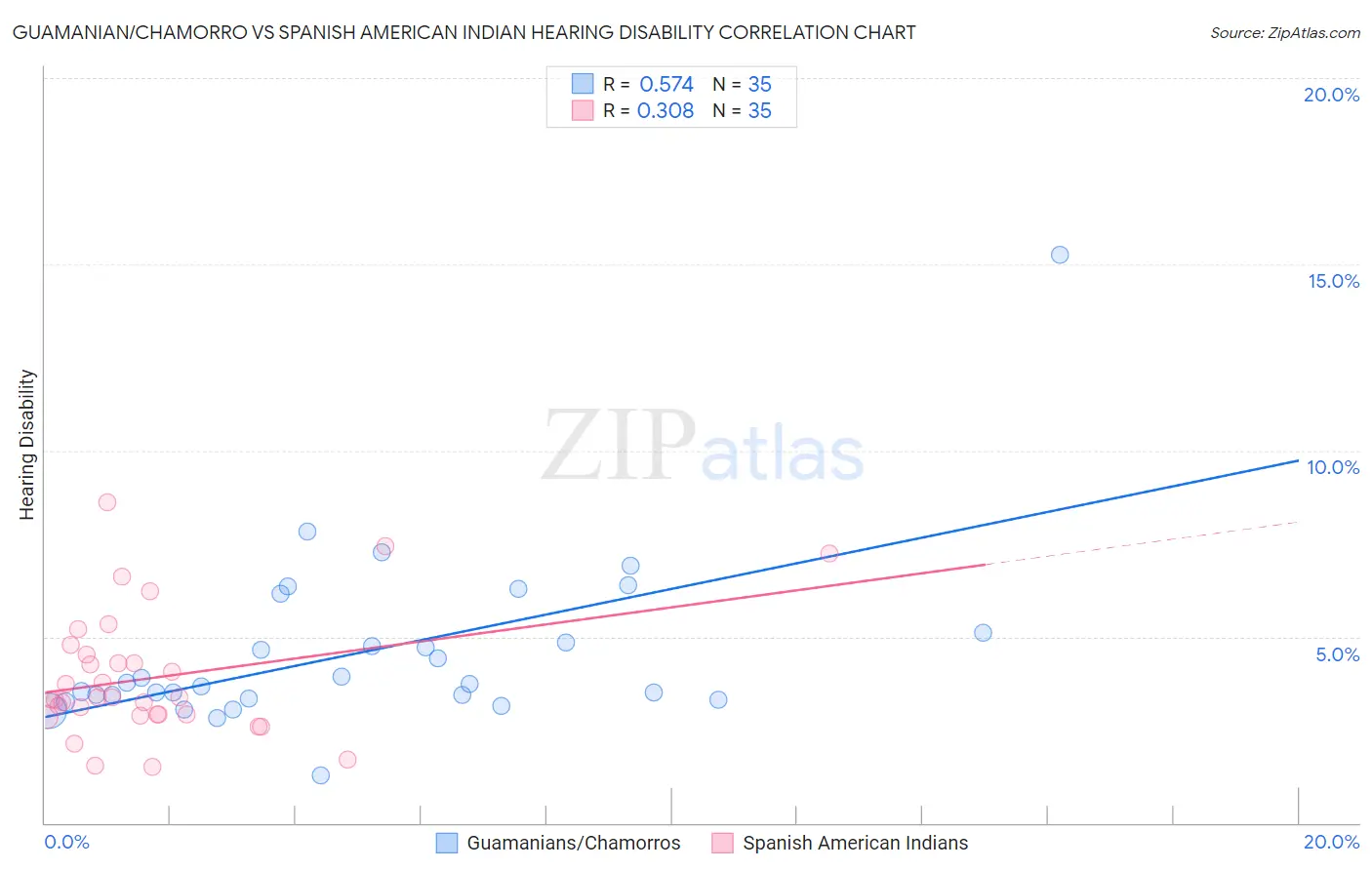Guamanian/Chamorro vs Spanish American Indian Hearing Disability
COMPARE
Guamanian/Chamorro
Spanish American Indian
Hearing Disability
Hearing Disability Comparison
Guamanians/Chamorros
Spanish American Indians
3.3%
HEARING DISABILITY
2.2/ 100
METRIC RATING
235th/ 347
METRIC RANK
3.1%
HEARING DISABILITY
24.1/ 100
METRIC RATING
195th/ 347
METRIC RANK
Guamanian/Chamorro vs Spanish American Indian Hearing Disability Correlation Chart
The statistical analysis conducted on geographies consisting of 221,861,125 people shows a substantial positive correlation between the proportion of Guamanians/Chamorros and percentage of population with hearing disability in the United States with a correlation coefficient (R) of 0.574 and weighted average of 3.3%. Similarly, the statistical analysis conducted on geographies consisting of 73,148,341 people shows a mild positive correlation between the proportion of Spanish American Indians and percentage of population with hearing disability in the United States with a correlation coefficient (R) of 0.308 and weighted average of 3.1%, a difference of 6.0%.

Hearing Disability Correlation Summary
| Measurement | Guamanian/Chamorro | Spanish American Indian |
| Minimum | 1.3% | 1.5% |
| Maximum | 15.2% | 8.6% |
| Range | 14.0% | 7.1% |
| Mean | 4.6% | 3.9% |
| Median | 3.7% | 3.4% |
| Interquartile 25% (IQ1) | 3.3% | 2.9% |
| Interquartile 75% (IQ3) | 5.1% | 4.5% |
| Interquartile Range (IQR) | 1.8% | 1.6% |
| Standard Deviation (Sample) | 2.4% | 1.7% |
| Standard Deviation (Population) | 2.3% | 1.7% |
Similar Demographics by Hearing Disability
Demographics Similar to Guamanians/Chamorros by Hearing Disability
In terms of hearing disability, the demographic groups most similar to Guamanians/Chamorros are Serbian (3.3%, a difference of 0.060%), Central American Indian (3.3%, a difference of 0.10%), Estonian (3.3%, a difference of 0.17%), Immigrants from Austria (3.3%, a difference of 0.46%), and German Russian (3.3%, a difference of 0.46%).
| Demographics | Rating | Rank | Hearing Disability |
| Immigrants | Portugal | 4.3 /100 | #228 | Tragic 3.2% |
| Maltese | 4.1 /100 | #229 | Tragic 3.2% |
| Greeks | 3.2 /100 | #230 | Tragic 3.2% |
| Luxembourgers | 2.9 /100 | #231 | Tragic 3.2% |
| Ukrainians | 2.9 /100 | #232 | Tragic 3.2% |
| Estonians | 2.4 /100 | #233 | Tragic 3.3% |
| Central American Indians | 2.3 /100 | #234 | Tragic 3.3% |
| Guamanians/Chamorros | 2.2 /100 | #235 | Tragic 3.3% |
| Serbians | 2.2 /100 | #236 | Tragic 3.3% |
| Immigrants | Austria | 1.8 /100 | #237 | Tragic 3.3% |
| German Russians | 1.8 /100 | #238 | Tragic 3.3% |
| Nepalese | 1.2 /100 | #239 | Tragic 3.3% |
| Immigrants | Netherlands | 1.1 /100 | #240 | Tragic 3.3% |
| Samoans | 1.1 /100 | #241 | Tragic 3.3% |
| Yugoslavians | 1.0 /100 | #242 | Tragic 3.3% |
Demographics Similar to Spanish American Indians by Hearing Disability
In terms of hearing disability, the demographic groups most similar to Spanish American Indians are South African (3.1%, a difference of 0.050%), Immigrants from Europe (3.1%, a difference of 0.16%), Macedonian (3.1%, a difference of 0.35%), Korean (3.1%, a difference of 0.42%), and Immigrants from Bosnia and Herzegovina (3.1%, a difference of 0.46%).
| Demographics | Rating | Rank | Hearing Disability |
| Mexican American Indians | 34.7 /100 | #188 | Fair 3.0% |
| Africans | 32.9 /100 | #189 | Fair 3.0% |
| Immigrants | South Africa | 31.1 /100 | #190 | Fair 3.1% |
| Immigrants | Switzerland | 28.8 /100 | #191 | Fair 3.1% |
| Koreans | 27.6 /100 | #192 | Fair 3.1% |
| Macedonians | 27.0 /100 | #193 | Fair 3.1% |
| South Africans | 24.5 /100 | #194 | Fair 3.1% |
| Spanish American Indians | 24.1 /100 | #195 | Fair 3.1% |
| Immigrants | Europe | 22.9 /100 | #196 | Fair 3.1% |
| Immigrants | Bosnia and Herzegovina | 20.6 /100 | #197 | Fair 3.1% |
| Immigrants | Croatia | 20.5 /100 | #198 | Fair 3.1% |
| Syrians | 19.2 /100 | #199 | Poor 3.1% |
| Immigrants | North Macedonia | 19.1 /100 | #200 | Poor 3.1% |
| Iraqis | 19.0 /100 | #201 | Poor 3.1% |
| Immigrants | Thailand | 16.4 /100 | #202 | Poor 3.1% |